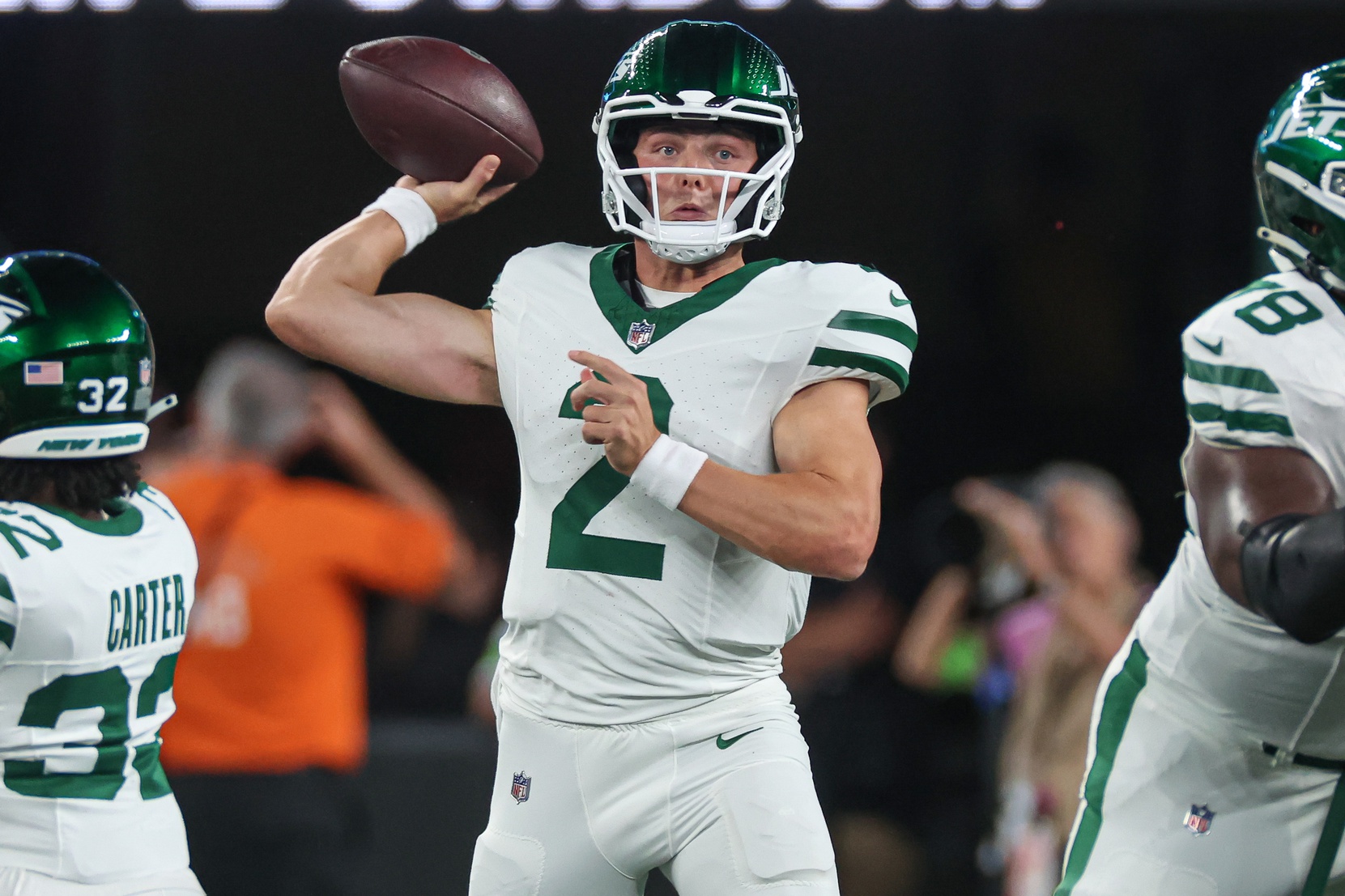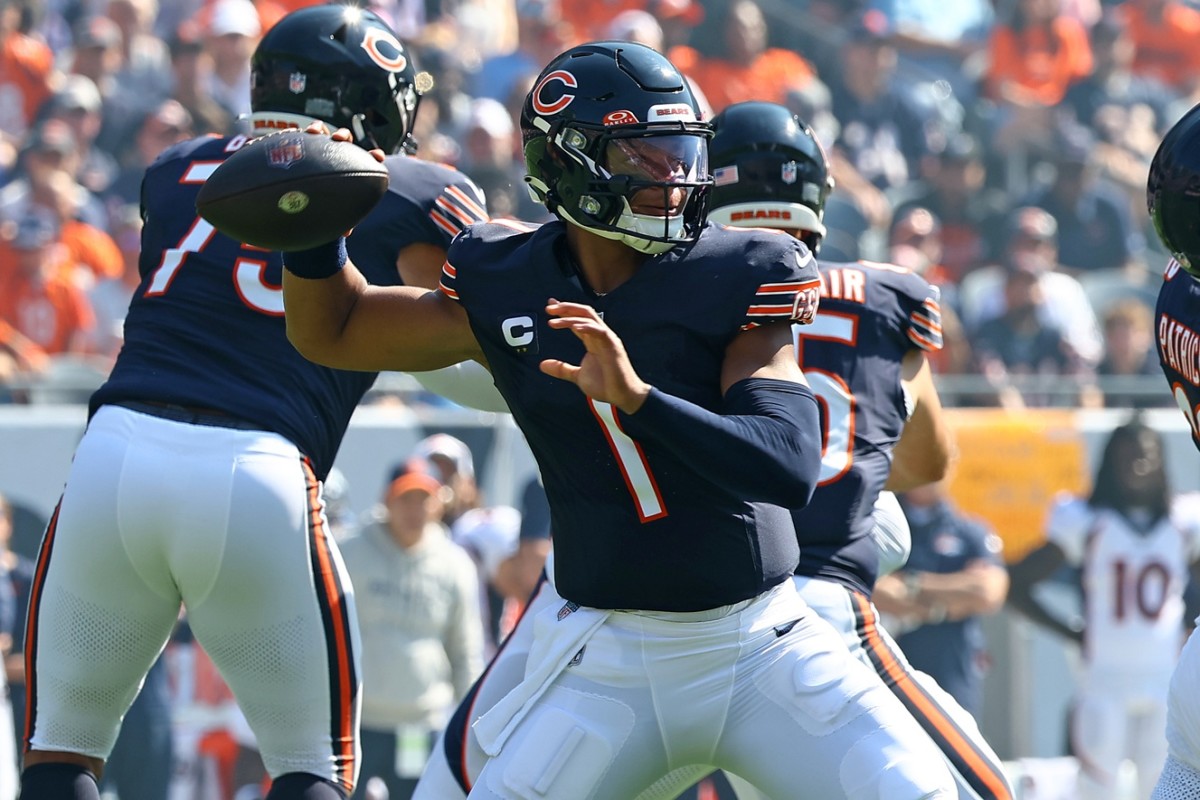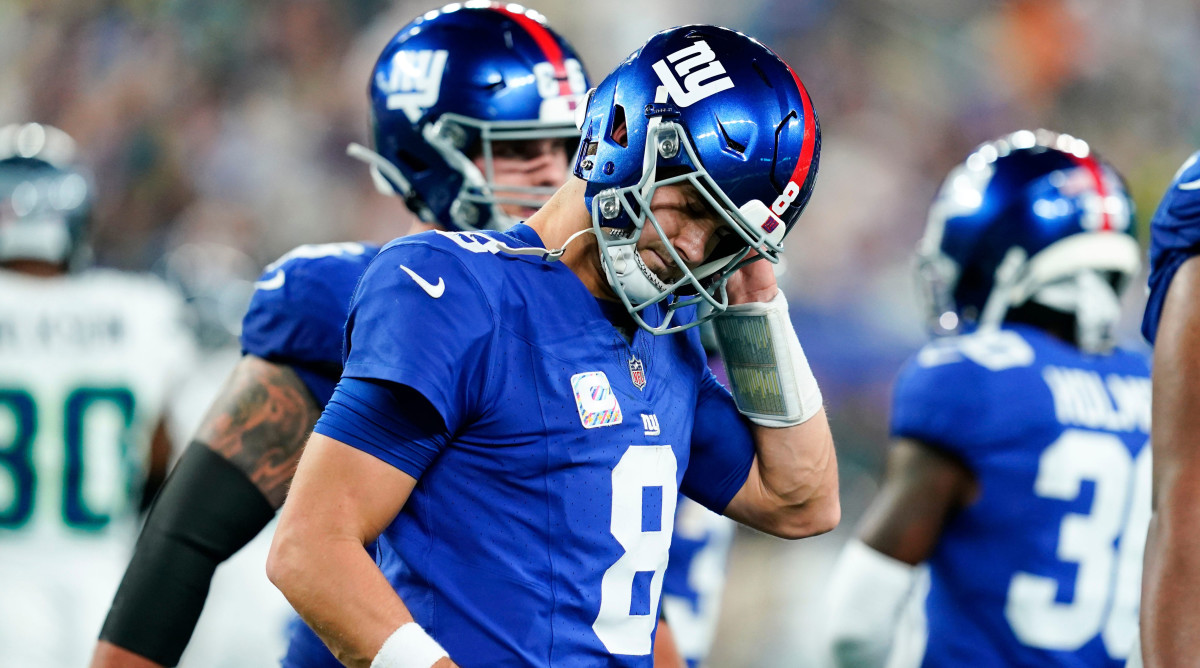Zach Wilson’s One Statistical Line That Should Have Jets Fans Excited
Digging out from Week 4 of the NFL schedule, let’s dive into the fallout …
• If there’s one statistical line that should actually get people excited not about how Zach Wilson played against the Chiefs, but how that projects going forward, it’d be this one: 26-of-34, 233 yards, 2 TDs, 0 INTs.
Those are the third-year quarterback’s numbers after the Jets fell behind 17–0 against the Super Bowl champions late in the first quarter.
For the Jets’ staff, it was confirmation that Wilson, who hadn’t played very well to that point, was playing with a psychological resilience that he hadn’t during his first two years. Only adding to that is everything Wilson had to hear over the course of September, on how misguided the Jets were to stick with him after losses to the Cowboys and the Patriots.
Watch the Jets with Fubo. Start your free trial today.

And now, as I see it, there’s reason for guarded optimism that the Jets are going to keep taking steps with Wilson at quarterback—and I know how that’s going to sound to a lot of people who were, understandably, out on Wilson after his first two seasons.
The first piece of this, to me, is where the offensive system is going. Aaron Rodgers, old school in a Peyton Manning kind of way, has long favored playing in an offense devoid of much motion or pre-snap movement. The reason for that is, simply, because he wants to be looking at the defense as he breaks the huddle and making his own adjustments, with a stagnant initial look giving him the chance to move teammates around.
Wilson, conversely, has played—like most young quarterbacks—in systems heavy on motion and pre-snap movement. So the Jets are trying to get back to doing more of that, but it’s easier said than done after building an offense for Rodgers that had guys standing in place until otherwise directed by the quarterback. And it’s a process not just for the quarterback and the coaches, but also the other 10 guys in the huddle.
The second piece is Wilson’s own development under offensive coordinator Nathaniel Hackett and pass-game coordinator Todd Downing, who are now learning, piece by piece, what works and what doesn’t in game settings for Wilson. That, too, should improve over time, and already has—the Jets took a shot on the first play of the Chiefs game, which was a product of increased confidence in Wilson. And the work is not just with the schematic stuff, either.
Fundamentally, Hackett and Downing have drilled down on overhauling Wilson’s footwork, and the belief is they’re already getting a more accurate quarterback as a result. It was, to the coaches, apparent on three throws from the pocket, with feet set, on the first drive of the second half—a back-shoulder throw on a seam route to Tyler Conklin, a slot fade to Jeremy Ruckert and a tight-window throw to Allen Lazard for the touchdown.
And so, no, I’m not saying that the Jets have saved their season, or that we’ll see Wilson in the Pro Bowl, or that the quarterback will be a bridge to Rodgers’s making a miraculous recovery from Achilles surgery. But with the Jets’ schedule softening here a bit, I’m not going to be surprised if Wilson at least shows us why Robert Saleh and Joe Douglas didn’t panic when their young quarterback looked pretty bad at the end of September.
• As for Rodgers, I’m told he’s been a great sounding board for Wilson.
He stayed in Jersey for a couple of days after the Jets game, and he’s been in constant communication with Wilson over the past couple of weeks. My understanding is that Rodgers will be going back and forth between Jersey and California for the rest of the season, with, obviously, his primary focus on rehabbing.
As for the possibility that Rodgers actually is ready to play by January, it sounds like he really believes it’s possible. Of course, the Jets would have to make the playoffs in the AFC, and that won’t be easy.
• So what was the difference in Justin Fields this week vs. previous weeks?
The Bears saw a couple of things. First, there was how well the team ran the ball, which has been a key for Fields going back to college (look at his throwing numbers when J.K. Dobbins and Trey Sermon were really rolling at Ohio State). Chicago ran for 177 yards, and that allowed for more manageable down-and-distance situations and simpler defensive looks. Second, there were simply more plays. The Bears ran 70, significantly more than the 51 they had in Weeks 2 and 3 against the Buccaneers and Chiefs.
As for what Fields did better, the coaches saw a guy who was being more aggressive when opportunities were there and taking checkdowns when they weren’t—and that was, of course, easier because the run game was effective and the offense was efficient.
Now, the turnovers in the second half, obviously, weren’t ideal. One wasn’t really Fields’s fault, but the other was on him. Both cost the Bears. But there’s at least a little more hope in how the quarterback played, and that the plan Luke Getsy and the offensive staff put together to develop Fields over the course of this season is coming together.
We’ll see if it stays together against a good Commanders defense Thursday night.

• As for Fields’s draft classmate Mac Jones, he seemed to go in the other direction Sunday, and has plateaued after an encouraging start to the season in a close loss to the Eagles. It’ll be interesting to see where Jones goes from here, because the widespread perception of him predraft in 2021 hasn’t moved much: That what you see is what you get.
“It does look hard for him [physically],” says one top executive from a team that played New England this year. “Mac came from Alabama—they ran the ball, they had the weapons outside, they had the play-action pass game, the anticipation, all those things. And the Patriots aren’t doing that with him because they don’t have the personnel. They’ve run some three tight-end stuff, and most people just run the ball from there, but they’re doing it looking for matchups, and throwing the ball with it, and that should tell you something.
“He’s a quick-trigger, efficient, rhythm-and-timing passer. If you’re playing a quick game and play-action with him, that’s great. If you have him sitting there processing, and throwing into tight spots, that’s not great. … And New England hasn’t drafted great. The offensive line is ehhhh. The receivers are ehhhh. And now they’re expecting a miracle from someone who needs good things around him. You can win with him. He won’t be the reason you win.”
Which, again, seems to confirm that the Patriots got what everyone thought they would—a good quarterback who might lack the ability to level up.
• While we’re on New England, the loss of Matthew Judon is devastating for the Patriots’ defense—and it’s going to be costly for the star edge rusher, too.
Judon pushed for a revision this offseason to the four-year, $56 million deal he signed during 2021, and he got it. The Patriots moved $3 million in base pay from ’24 into this year and added $3 million in incentives. Judon would get $1 million for playing 75% of the team’s snaps and making the playoffs; $1 million for making the Pro Bowl and the playoffs; $500,000 for being first- or second-team All-Pro; and another $500,000 for making first- or second-team All-Pro and making the playoffs.
So Judon loses the chance at $3 million with the injury. And he’ll lose about $58,823 in per-game roster bonuses for each week he’s out (that’ll add up to about $765,705 if he’s out for the year, which is certainly a possibility).
That means, essentially, that Judon will make half the raise the Patriots gave him this summer after what would probably be best termed as a soft “hold-in”.
• I mentioned this in The MMQB yesterday—if you eliminate the Cardinals game, the Cowboys’ defense is on a really torrid pace. In Dallas’s other three games—against the two New York teams and New England—the Cowboys generated 10 turnovers, 12 sacks and three defensive touchdowns, while allowing only one touchdown (that was the long one from Zach Wilson to Garrett Wilson in the Jets game).
And just as the Cowboys have their headliners on defense, and obviously Micah Parsons is at the top of that list, there are a lot of unsung heroes in the group. Sixth-year defensive end Dorance Armstrong is certainly one; he’s been developed by Dallas since the Cowboys took him in the fourth round in 2018. He’s been stout against the run and effective enough as a pass rusher to not just get to the quarterback, but also set up others for sacks, while also serving a role on special teams.
The Cowboys valued Armstrong enough to give him a two-year, $12 million extension in 2022. He’ll be a free agent after this season.
• Devon Witherspoon on Monday night showed who he is as a playmaker, hitter and cover man, and why the Seahawks were willing to go away from their normal mold at corner—Pete Carroll’s always favored the taller, longer prospect at that position.
Their willingness to do so (Witherspoon is 6'0"), and at such an early point of the draft, is indicative of two things.
First, it’s that the Seahawks’ system has evolved and isn’t nearly as cover-3 heavy as it has been traditionally, with far more man and pattern-match zone looks that require better man-to-man players, and a more versatile array of them (they already have a Carroll prototype in second-year man Riq Woolen). Second, as Seattle assessed Witherspoon, he had exceptional marks in literally every category other than height, which is what would cause you to make an exception. And it’s safe to say the Seahawks are glad they did.

• Silver lining for the Giants from an awful night and a 1–3 start—the team’s decision-makers were right in taking a measured, realistic approach coming out of their first year.
It would’ve been easy, of course, for Joe Schoen and Brian Daboll to accelerate their plans after making the playoffs in their first year and advancing a round when they got there. They resisted the urge to do it, instead focusing the offseason on the draft and getting their own guys (Daniel Jones, Andrew Thomas, Dexter Lawrence, Saquon Barkley) signed, knowing they still have a ways to go.
For all the fan base’s complaints about upgrading the skill positions on offense or the inactivity during free agency, that approach was the right one. In a roundabout way, Monday showed us that.
• And if we’re talking silver linings, there was the inverse, too, this week—the Bills’ losing Tre’Davious White for the year. More than anything, at least in the short term, it’ll put the development of 2022 first-rounder Kaiir Elam, who’s been a disappointment to this point, under a microscope.
Any sort of breakthrough from Elam would obviously be huge for Buffalo.
• As we said Friday, the Colts haven’t gotten calls on Jonathan Taylor. Indianapolis getting Taylor—who’s worked his tail off—back on the field could change that, and Taylor’s returning to the practice field Wednesday.
At this point, I do think Indianapolis would listen. The Colts’ run game has been solid without Taylor and, if the outlook on re-signing him is bleak, it might make sense for Indy to get what it can now.
And I say that as someone who’d endorse paying him. It’s just that, at this point, they’ve looked O.K. without him, and I do think he’d bring value to another team. Whether another team would give up a good pick and a contract is another question, and that probably will dictate whether he gets moved.
• Now everyone is trying the Brotherly Shove of a rugby play the Eagles have used to great effect over the past couple of years, and guess what? It’s not as automatic as Bo Jackson in Tecmo Bowl. Turns out, the Eagles are just so good at it that it’s looked that way.
